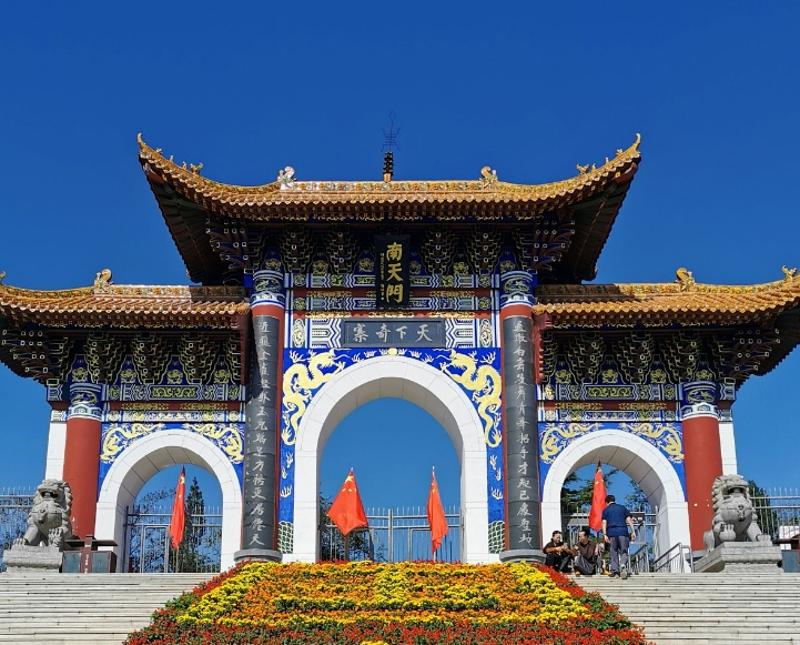Nantianmen

Mount Tai: The South Heaven Gate, a Majestic Gateway to the Celestial Realm
Mount Tai, the most revered among the Five Great Mountains, is renowned for its majestic grandeur and has been hailed as the "Number One Mountain under Heaven" since ancient times. The South Heaven Gate, towering skyward at the peak of Mount Tai, is one of the most awe-inspiring sights of this magnificent mountain. It not only serves as a landmark of the Mount Tai Scenic Area but also embodies the "unity of heaven and man" philosophy, a cornerstone of Chinese traditional culture.
I. The South Heaven Gate: Entrance to the Celestial Realm
Geographical Location: The South Heaven Gate is situated on the southern side of Mount Tai's Jade Emperor Peak, at an elevation of 1460 meters. It is a mandatory passage for ascending Mount Tai.
Architectural Structure: The South Heaven Gate is composed of three arched doorways, meticulously crafted from blue stone, showcasing a simple yet majestic design. The inscription "South Heaven Gate" is boldly engraved in gold above the archways, exuding an aura of grandeur.
Historical and Cultural Significance: In ancient times, the South Heaven Gate was believed to be the entrance to the celestial realm, a crucial passage for deities to travel between heaven and earth. Numerous myths and folk tales are intertwined with the South Heaven Gate, such as:
- The legend of Qin Shi Huang ascending Mount Tai to perform a grand sacrifice, believed to have entered the celestial realm through the South Heaven Gate to meet with the Heavenly Emperor.
- The folklore surrounding celestial guards stationed at the South Heaven Gate, permitting passage only to those authorized by the heavens.
Religious Significance: The South Heaven Gate holds immense significance in Taoism, serving as a crucial site for Taoist rituals. Taoists believe it to be the gateway to the celestial realm, the abode of Taoist deities. Many legends about Taoist deities are associated with the South Heaven Gate, such as:
- The belief that the Jade Emperor resides above the South Heaven Gate, overseeing the three realms.
- The practice of Taoist deities conducting ceremonies at the South Heaven Gate to invoke blessings and good fortune.
II. The South Heaven Gate: A Necessary Step in Ascending Mount Tai
A Challenging Climb: Reaching the South Heaven Gate requires traversing the Eighteen Turns, a winding and treacherous mountain path. This path spans approximately 1600 meters, constructed of uneven stone steps, demanding caution and careful navigation.
Magnificent Views: As you ascend the Eighteen Turns, you can admire the majestic beauty of Mount Tai, experiencing the breathtaking feeling of "looking down upon all the mountains beneath you."
A Spiritual Cleansing: Reaching the South Heaven Gate allows you to feel the awe-inspiring power of Mount Tai, to comprehend the philosophy of "standing on Mount Tai and feeling small in comparison to the world," to cleanse your soul, and to attain a spiritual elevation.
III. The South Heaven Gate: A Landmark of the Mount Tai Scenic Area
A Tourist Destination: The South Heaven Gate is a prominent landmark within the Mount Tai Scenic Area, attracting countless visitors each year.
A Photographer's Paradise: The South Heaven Gate is a paradise for photography enthusiasts, offering opportunities to capture the stunning scenery of Mount Tai and the majestic architecture of the South Heaven Gate itself.
Preservation of Culture: The South Heaven Gate stands as a crucial symbol of Chinese traditional culture, steeped in rich historical and cultural significance. It is an integral part of China's cultural heritage.
Conclusion
The South Heaven Gate, a majestic and magnificent structure, is not only the entrance to the summit of Mount Tai but also a symbol of Chinese traditional culture and spiritual aspirations. Its unique allure draws countless visitors to experience the mystique and grandeur of Mount Tai, finding spiritual cleansing and elevation in the process.